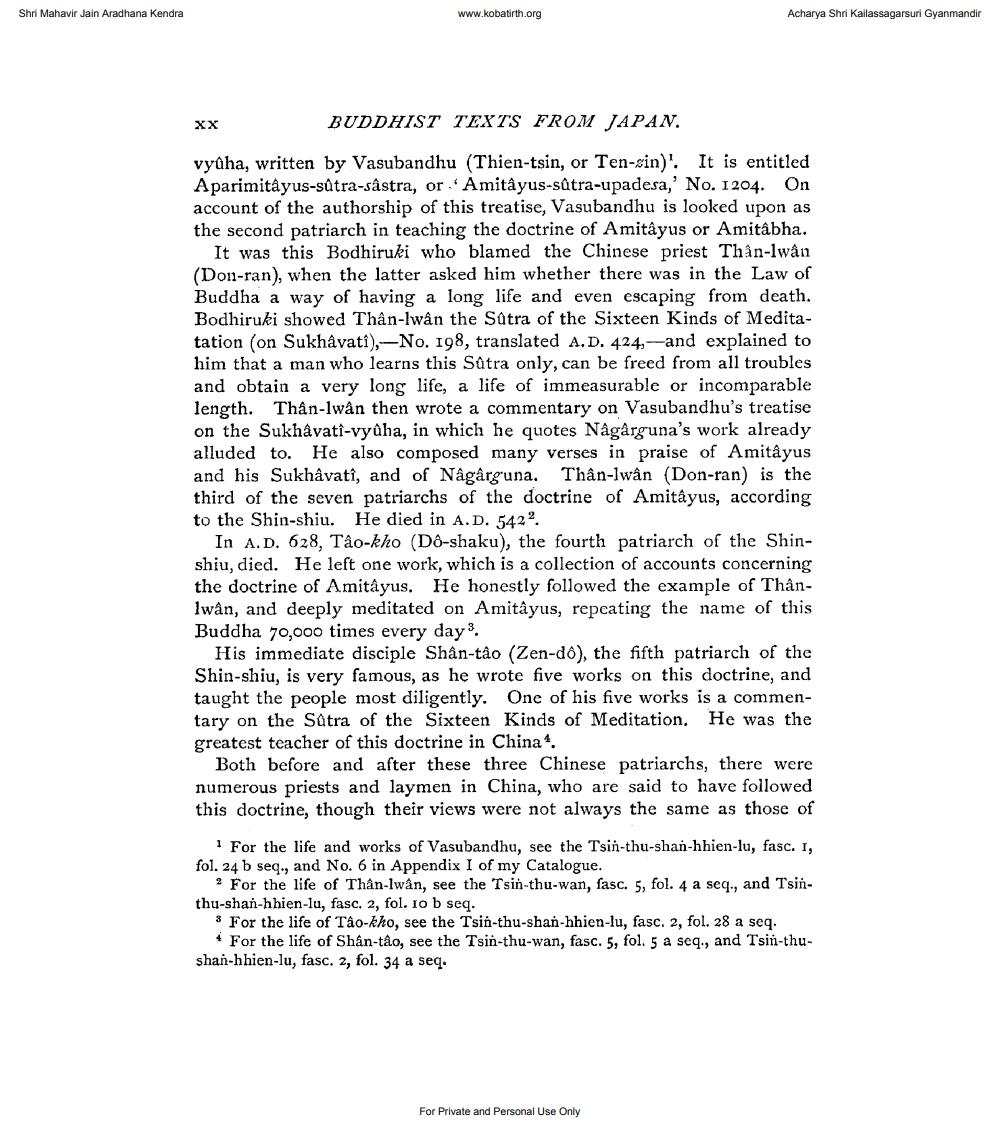________________
Shri Mahavir Jain Aradhana Kendra
www.kobatirth.org
Acharya Shri Kailassagarsuri Gyanmandir
xx
BUDDHIST TEXTS FROM JAPAN.
vydha, written by Vasubandhu (Thien-tsin, or Ten-sin)'. It is entitled Aparimitâyus-sůtra-sastra, or Amitâyus-sâtra-upadesa,' No. 1 204. On account of the authorship of this treatise, Vasubandhu is looked upon as the second patriarch in teaching the doctrine of Amitâyus or Amitabha.
It was this Bodhiruki who blamed the Chinese priest Thân-lwân (Don-ran), when the latter asked him whether there was in the Law of Buddha a way of having a long life and even escaping from death. Bodhiruki showed Thân-lwân the Satra of the Sixteen Kinds of Meditatation (on Sukhavati),-No. 198, translated A.D. 424,--and explained to him that a man who learns this Satra only, can be freed from all troubles and obtain a very long life, a life of immeasurable or incomparable length. Thân-Iwan then wrote a commentary on Vasubandhu's treatise on the Sukhavati-vyuha, in which he quotes Nâgârguna's work already alluded to. He also composed many verses in praise of Amitäyus and his Sukhâvatî, and of Nâgârguna. Thân-lwân (Don-ran) is the third of the seven patriarchs of the doctrine of Amitäyus, according to the Shin-shiu. He died in A.D. 5422
In A.D. 628, Tao-kho (Dô-shaku), the fourth patriarch of the Shinshiu, died. He left one work, which is a collection of accounts concerning the doctrine of Amitâyus. He honestly followed the example of ThânIwan, and deeply meditated on Amitâyus, repeating the name of this Buddha 70,000 times every day.
His immediate disciple Shân-tão (Zen-do), the fifth patriarch of the Shin-shiu, is very famous, as he wrote five works on this doctrine, and taught the people most diligently. One of his five works is a commentary on the Satra of the Sixteen Kinds of Meditation. He was the greatest teacher of this doctrine in China
Both before and after these three Chinese patriarchs, there were numerous priests and laymen in China, who are said to have followed this doctrine, though their views were not always the same as those of
For the life and works of Vasubandhu, see the Tsin-thu-shan-hhien-lu, fasc. I, fol. 24 b seq., and No. 6 in Appendix I of my Catalogue.
2 For the life of Thân-lwân, see the Tsin-thu-wan, fasc. 5, fol. 4 a seq., and Tsinthu-shan-hhien-lu, fasc. 2, fol. 10 b seq. 3 For the life of Tao-kho, see the Tsin-thu-shan-hhien-lu, fasc. 2, fol. 28 a seq.
For the life of Shân-tao, see the Tsin-thu-wan, fasc. 5, fol. 5 a seq., and Tsin-thushan-hhien-lu, fasc. 2, fol. 34 a seq.
For Private and Personal Use Only




